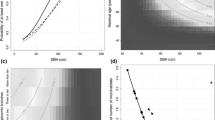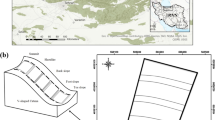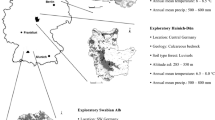Abstract
Key message
The intensity of silvicultural interventions and the neighborhood composition determine branching patterns, crown shape, and trunk attributes of beech ( Fagus sylvatica L.) trees.
Abstract
The intensity of silvicultural interventions and the composition of tree species are important forest management decisions. Both determine tree shape and thus influence the value of a tree, be it in terms of economy (trunk form, branchiness), or in terms of ecology (microhabitats). However, our knowledge on the distinct changes in tree architecture due to silvicultural management intensity or different neighborhood diversities is still limited, especially if the focus is on single tree attributes, e.g., branching patterns or crown shapes. We used terrestrial laser scanner data to calculate 25 structural measures for 55 European beech (Fagus sylvatica L.) trees that grew either in pure stands along a gradient of management intensity or in intra or interspecific neighborhoods in unmanaged stands. We found a lower height of maximal horizontal crown extension, a higher crown surface area, and straighter trunks with increasing management intensity. Moreover, our study revealed that beech trees surrounded by valuable hardwoods showed a lower height of maximal horizontal crown extension, a lower height–diameter ratio, and longer branches with flatter branch angles than beech trees surrounded by conspecific neighbors. Our findings provide evidence of phenotypic plasticity of European beech to diverse environmental conditions. The differences in tree structure indicate an increasing crown competition with decreasing management intensity and stronger competitive pressure for beech surrounded by conspecific neighbors in comparison to alien neighbors.

Basemap: Bing Aerial Maps





Similar content being viewed by others
References
Ammer C, Puettmann KJ (2009) Waldbau, quo vadis?—Waldbewirtschaftung zwischen Funktionsorientierung und Multifunktionalität (The road ahead of forest management—single or multiple management objectives). FoArch 80:90–96
Bayer D, Seifert S, Pretzsch H (2013) Structural crown properties of Norway spruce (Picea abies [L.] Karst.) and European beech (Fagus sylvatica [L.]) in mixed versus pure stands revealed by terrestrial laser scanning. Trees 27(4):1035–1047
Bravo-Oviedo A, Pretzsch H, Ammer C, Andenmatten E, Barbati A, Barreiro S, Brang P, Bravo F, Coll L, Corona P, den Ouden J, Ducey MJ, Forrester DI, Giergiczny M, Jacobsen JB, Lesinski J, Löf M, Mason B, Matovic B, Metslaid M, Morneau F, Motiejunaite J, O’Reilly C, Pach M, Ponette Q, del Río M, Short I, Skovsgaard JP, Soliño M, Spathelf P, Sterba H, Stojanovic D, Strelcova K, Svoboda M, Verheyen K, von Lüpke N, Zlatanov T (2014) European mixed forests: definition and research perspectives. For Syst 23:518–533
Brown PL, Doley D, Keenan RJ (2004) Stem and crown dimensions as predictors of thinning responses in a crowded tropical rainforest plantation of Flindersia brayleyana F. Muell. For Ecol Manag 196(2):379–392
Calders K, Newnham G, Burt A, Murphy S, Raumonen P, Herold M, Culvenor D, Avitabile V, Disney M, Armston J, Kaasalainen M (2015) Nondestructive estimates of above-ground biomass using terrestrial laser scanning. Methods Ecol Evol 6:198–208
Canham CD, Finzi AC, Pacala SW, Burbank DH (1994) Causes and consequences of resource heterogeneity in forests: interspecific variation in light transmission by canopy trees. Can J For Res 24(2):337–349
CEN (1995) Softwood timber. Qualitative classification. prEN 1927:ff. Brussels: Comité Européen de Normalisation
CEN (1997a) Hardwood round timber. Qualitative classification. prEN 1316:ff. Brussels: Comité Européen de Normalisation
Cremer KW, Borough CJ, McKinnell FH, Carter PR (1982) Effects of stocking and thinning on wind damage in plantations. N Z J For Sci 12(2):244–268
Danson FM, Hetherington D, Morsdorf F, Koetz B, Allgöwer B (2007) Forest canopy gap fraction from terrestrial laser scanning. IEEE Geosci Remote Sens Lett 4(1):157–160
Dieler J, Pretzsch H (2013) Morphological plasticity of European beech (Fagus sylvatica L.) in pure and mixed-species stands. For Ecol Manag 295(1):97–108
Ehrenberg C (1970) Breeding for stem quality. Unasylva 24(97/98):23–31
Fichtner A, Sturm K, Rickert C, von Oheimb G, Härdtle W (2013) Crown size-growth relationships of European beech (Fagus sylvatica L.) are driven by the interplay of disturbance intensity and inter-specific competition. For Ecol Manag 302:178–184
Fischer M, Bossdorf O, Gockel S, Hänsel F, Hemp A, Hessenmöller D, Korte G, Pfeiffer S, Prati D, Renner S, Schöning I, Schumacher U, Wells K, Buscot F, Kalko EKV, Linsenmair KE, Schulze E-D, Weisser WW (2010) Implementing large-scale and long-term functional biodiversity research: the biodiversity exploratories. Basic Appl Ecol 11(6):473–485
Gary HL (1978) The vertical distribution of needles and branchwood in thinned and unthinned 80-year-old lodgepole pine. Northwest Sci 52:303–309
Gentle JE (1998) QR factorization. Numerical linear algebra for applications in statistics. Springer, Berlin, pp 95–97
Guericke M (2001) Untersuchungen zur Wuchsdynamik von Mischbeständen aus Buche und Europ. Lärche (Larix decidua Mill.) als Grundlage für ein abstandsabhängiges Einzelbaumwuchsmodell. Dissertation, University of Goettingen
Hamilton GJ (1981) The effects of high intensity thinning on yield. Forestry 54(1):1–15
Hawley RC (1946) Practice of silviculture, 5th edn. John Wiley & Sons, New York
Hopkinson C, Chasmer L, Young-Pow C, Treitz P (2004) Assessing forest metrics with a ground-based scanning lidar. Can J For Res 34:573–583
Ishii H, Asano S (2010) The role of crown architecture, leaf phenology and photosynthetic activity in promoting complementary use of light among coexisting species in temperate forests. Ecol Res 25(4):715–722
Juchheim J, Ammer C, Schall P, Seidel D (2017) Canopy space filling rather than conventional measures of structural diversity explains productivity of beech stands. For Ecol Manag 395:19–26
Jucker T, Bouriaud O, Coomes DA (2015) Crown plasticity enables trees to optimize canopy packing in mixed-species forests. Funct Ecol 29(8):1078–1086
Kimmins JP (2004) Forest Ecology: a foundation for sustainable forest management and environmental ethics in forestry, 3rd edn. Prentice Hall, Upper Saddle River
Knoke T, Schulz-Wenderoth S (2001) Ein Ansatz zur Beschreibung von Wahrscheinlichkeit und Ausmaß der Farbkernbildung bei Buche (Fagus sylvatica L.). Forstwiss Centralbl 120:154–172
Lang AC, Härdtle W, Bruelheide H, Geißler C, Nadrowski K, Schuldt A, von Oheimb G (2010) Tree morphology responds to neighbourhood competition and slope in species-rich forests of subtropical China. For Ecol Manag 260(10):1708–1715
Lang AC, Härdtle W, Bruelheide H, Kröber W, Schröter M, von Wehrden H, Oheimb G (2012) Horizontal, but not vertical canopy structure is related to stand functional diversity in a subtropical slope forest. Ecol Res 27(1):181–189
Larson L, Kretschmann DD, Clark III A, Isebrands JG (2001) Formation and properties of juvenile wood in southern pines: a synopsis. Gen. Tech. Rep. FPL-GTR-129. U.S. Department of Agriculture Forest Service, Forest Products Laboratory, Madison, WI
Lintunen A (2013) Crown architecture and its role in species interactions in mixed boreal forests. Dissertation, University of Helsinki
Macdonald E, Hubert J (2002) A review of the effects of silviculture on timber quality of Sitka spruce. Forestry 75(2):107–138
Maguire DA, Bennett WS (1996) Patterns in vertical distribution of foliage in young coastal Douglas-fir. Can J For Res 26:1991–2005
Matsuzaki J, Masumori M, Tange T (2006) Stem phototropism of trees: a possible significant factor in determining stem inclination on forest slopes. Ann Bot 98:573–581
Medhurst JL, Beadle CL (2001) Crown structure and leaf area index development in thinned and unthinned Eucalyptus nitens plantations. Tree Physiol 21:989–999
Metz J, Seidel D, Schall P, Scheffer D, Schulze ED, Ammer C (2013) Crown modeling by terrestrial laser scanning as an approach to assess the effect of aboveground intra-and interspecific competition on tree growth. For Ecol Manag 310:275–288
Montagu KD, Kearney DE, Smith RGB (2003) The biology and silviculture of pruning planted eucalypts for clear wood production—a review. For Ecol Manag 179(1):1–13
Newnham GJ, Armston JD, Calders K, Disney MI, Lovell JL, Schaaf CB, Strahler AH, Danson FM (2015) Terrestrial laser scanning for plot scale forest measurement. Curr For Rep 1:239–251
Olivier MD, Robert S, Fournier RA (2016) Response of sugar maple (Acer saccharum, Marsh.) tree crown structure to competition in pure versus mixed stands. For Ecol Manag 374:20–32
Pape R (1999) Effects of thinning regime on the wood properties and stem quality of Picea abies. Scand J For Res 14(1):38–50
Porté A, Bartelink HH (2002) Modelling mixed forest growth: a review of models for forest management. Ecol Model 150(1):141–188
Pretzsch H (2014) Canopy space filling and tree crown morphology in mixed-species stands compared with monocultures. For Ecol Manag 327:251–264
Pretzsch H, Schütze G (2009) Transgressive overyielding in mixed compared with pure stands of Norway spruce and European beech in Central Europe: evidence on stand level and explanation on individual tree level. Eur J For Res 128:183–204
Pretzsch H, del Río M, Schütze G, Ammer C, Annighöfer P, Avdagic A, Barbeito I, Bielak K, Brazaitis G, Coll L, Drössler L, Fabrika M, Forrester DI, Kurylyak V, Löf M, Lombardi F, Mohren F, Motta R, Pach M, Ponette Q, Sramek V, Sterba H, Stojanović D, Svoboda M, Verheyen K, Zlatanov T, Bravo-Oviedo A (2016) Mixing of Scots pine (Pinus sylvestris L.) and European beech (Fagus sylvatica L.) enhances structural heterogeneity, and the effect increases with humidity. For Ecol Manag 373:149–166
Puettmann KJ, Coates KD, Messier C (2009) A critique of silviculture. Managing for complexity. Island Press, Washington, DC
R Core Team (2014) R: a language and environment for statistical computing. R Foundation for Statistical Computing, Vienna, Austria
Raumonen P (2015) Quantitative structure tree models from terrestrial laser scanner data. In: Proceedings of Silvilaser 2015, 28–30 Sept, La Grande Motte, France
Raumonen P, Kaasalainen M, Åkerblom M, Kaasalainen S, Kaartinen H, Vastaranta M, Holopainen M, Disney M, Lewis P (2013) Fast automatic precision tree models from terrestrial laser scanner data. Rem Sens 5(2):491–520
Röhrig E, Bartsch N, von Lüpke B (2006) Waldbau auf ökologischer Grundlage, 7th edn. Ulmer Verlag, Stuttgart
Schall P, Ammer C (2013) How to quantify forest management intensity in Central European forests. Eur J For Res 132:379–396
Seidel D, Ammer C (2014) Efficient measurements of basal area in short rotation forests based on terrestrial laser scanning under special consideration of shadowing. iForest 7(4):227
Seidel D, Fleck S, Leuschner C, Hammett T (2011a) Review of ground-based methods to measure the distribution of biomass in forest canopies. Ann For Sci 68:225–244
Seidel D, Leuschner C, Müller A, Kraus B (2011b) Crown plasticity in mixed forests—quantifying asymmetry as a measure of competition using terrestrial laser scanning. For Ecol Manag 261(11):2123–2132
Seidel D, Fleck S, Leuschner C (2012) Analyzing forest canopies with ground-based laser scanning: a comparison with hemispherical photography. Agric For Meteorol 154:1–8
Seidel D, Schall P, Gille M, Ammer C (2015a) Relationship between tree growth and physical dimensions of Fagus sylvatica crowns assessed from terrestrial laser scanning. iForest 8:735–742
Seidel D, Hoffmann N, Ehbrecht M, Juchheim J, Ammer C (2015b) How neighborhood affects tree diameter increment—new insights from terrestrial laser scanning and some methodical considerations. For Ecol Manag 336:119–128
Shrestha R, Wynne RH (2012) Estimating biophysical parameters of individual trees in an urban environment using small footprint discrete-return imaging lidar. Rem Sens 4(2):484–508
Smith FW, Long JN (1989) The influence of canopy architecture on stemwood production and growth efficiency of Pinus contorta var. latifolia. J Appl Ecol 26:681–691
Takeda T, Oguma H, Sano T, Yone Y, Fujinama Y (2008) Estimating the plant area density of a Japanese larch (Larix kaempferi Sarg.) plantation using a ground-based laser scanner. Agric For Meteorol 148:428–438
Thies M, Pfeifer N, Winterhalder D, Gorte BGH (2004) Three-dimensional reconstruction of stems for assessment of taper, sweep and lean based on laser scanning of standing trees. Scand J For Res 19(6):571–581
Thorpe HC, Astrup R, Trowbridge A, Coates KD (2010) Competition and tree crowns: a neighborhood analysis of three boreal tree species. For Ecol Manag 259(8):1586–1596
Umeki K (1995) A comparison of crown asymmetry between Picea abies and Betula maximowicziana. Can J For Res 25:1876–1880
Valladares F (2003) Light heterogeneity and plants: from ecophysiology to species coexistence and biodiversity. In: Esser K, Lüttge U, Beyschlag W, Hellwig F (eds) Progress in Botany. Springer, Berlin, pp 439–471
Vospernik S, Monserud RA, Sterba H (2010) Do individual-tree growth models correctly represent height: diameter ratios of Norway spruce and Scots pine? For Ecol Manag 260(10):1735–1753
Watt PJ, Donoghue DNM (2005) Measuring forest structure with terrestrial laser scanning. Int J Remote Sens 26:1437–1446
Winter S, Möller GC (2008) Microhabitats in lowland beech forests as monitoring tool for nature conservation. For Ecol Manag 255(3):1251–1261
Wohlfarth E (1935) Auswirkungen langjähriger Kronenpflege in mitteldeutschen Fichtenbeständen. Z Forst Jagdwesen 67:289–310
Yoshida T, Kamitani T (2000) Interspecific competition among three canopy-tree species in a mixed-species even-aged forest of central Japan. For Ecol Manag 137:221–230
Acknowledgements
We thank the managers of the three Exploratories, Kirsten Reichel-Jung, Swen Renner, Katrin Hartwich, Sonja Gockel, Kerstin Wiesner, and Martin Gorke for their work in maintaining the plot and project infrastructure; Christiane Fischer and Simone Pfeiffer for giving support through the central office, Michael Owonibi for managing the central data base, and Markus Fischer, Eduard Linsenmair, Dominik Hessenmöller, Jens Nieschulze, Daniel Prati, Ingo Schöning, François Buscot, Ernst-Detlef Schulze, Wolfgang W. Weisser, and the late Elisabeth Kalko for their role in setting up the Biodiversity Exploratories project. The work has been funded by the DFG (German Science Foundation) Priority Program 1374 “Infrastructure-Biodiversity-Exploratories”. Field work permits were issued by the responsible state environmental offices of Baden-Württemberg, Thüringen, and Brandenburg (according to § 72 BbgNatSchG). This work was funded by research grants granted to Dominik Seidel (reference number: Se 2383/2-1) and Christian Ammer (reference number: Am 149/15-1) by the German Research Foundation and by a research scholarship granted to Dominik Seidel by the German Research Foundation (reference number: Se 2383/1-1).
Author information
Authors and Affiliations
Corresponding author
Ethics declarations
Conflict of interest
The authors declare that they have no conflict of interest.
Additional information
Communicated by G. Wieser.
Rights and permissions
About this article
Cite this article
Juchheim, J., Annighöfer, P., Ammer, C. et al. How management intensity and neighborhood composition affect the structure of beech (Fagus sylvatica L.) trees. Trees 31, 1723–1735 (2017). https://doi.org/10.1007/s00468-017-1581-z
Received:
Accepted:
Published:
Issue Date:
DOI: https://doi.org/10.1007/s00468-017-1581-z




